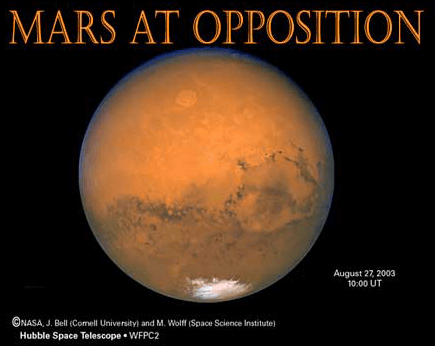All about Oppositions of Mars
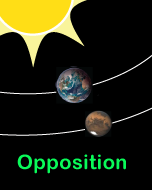
The best time to observe Mars is when it is on the opposite side from the Sun as viewed on Earth. This is when Earth has caught up with Mars and moves between it and the Sun. At this time, the two planets will be closest to each other in their orbits. - - Go to the latest opposition page.
Ordinarily Mars can be a difficult object to find in the night sky, as it can hide behind the Sun, skirt the horizon, and appear only as bright as a second magnitude star. Every 780 days, or roughly 2 years and 50 days, planet Earth passes Mars on its orbital track, overtaking the red planet. Opposition occurs at the moment Earth overtakes Mars. At that time, Mars will be seen all night after the Sun sets and present a full disk until dawn.
Since 780 days is an average, the actual number of days between oppositions depend upon where the planets are in their orbits. This is because planets move faster when their orbits bring them closer to the sun. When Mars is near perihelion, it can take the Earth many days longer than average to lap Mars, but when Mars is near aphelion, the Earth catch up faster than the average number of days.
The Earth's orbit is very nearly circular, but Mars' orbit is more eccentric, that is, it varies 0.093 from circular. This means the red planet is much closer to the Sun at perihelion (206 million km) than at aphelion (249 million km) a difference of 43 million km. In comparison, the difference between Earth's aphelion and perihelion distance is 5 million km. These distances vary, of course, and I have used extremes. But those differences mean the distance between Earth and Mars at opposition is variable. The count of 780 days (actually 778 days) between oppositions is called the "synodic" period of Mars.
The following table highlights the dates of recent and upcoming oppositions of Mars. If there is more information at the Gate, click on the link to discover more about the individual apparitions or read on to discover more about our second nearest planetary neighbor.
| Date | Disk Diameter | Magnitude |
| July 27, 2018 | 24.2" | -2.8 |
| October 13, 2020 | 22.4" | -2.6 |
| December 8, 2022 | 17.0" | -1.8 |
| January 16, 2025 | 14.5" | -1.2 |
| February 19, 2027 | 13.8" | -1.3 |
| March 25, 2029 | 14.5" | -1.3 |
| May, 2031 | 16.9" | -1.8 |
Notice how the magnitude and disk diameter of Mars at opposition is different for each date on the chart. This is because Mars and Earth in their orbits do not maintain the same distance between them. The distance to Mars is always changing. Sometimes it is closer and other times it is farther away. This is the reason that Mars can be an elusive planet to keep track of for dedicated planet watchers. It is also the reason that planetary missions to Mars have to be carefully planned.
Because Mars is an outer planet, its orbit is farther away from the Sun than Earth's orbit. In the regular course of outer planets, Mars reaches the same positions in respect with the Earth on a regular basis. Although both planets are constantly moving, their paths will meet at various positions in respect to the Sun as seen in the diagram.
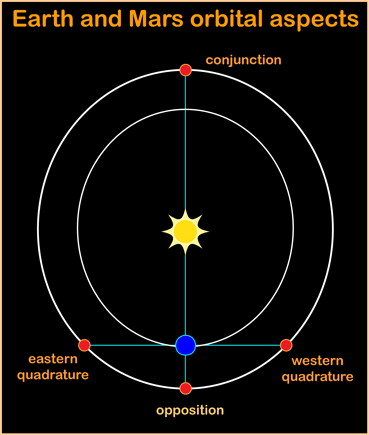
The position of Mars behind the Sun at conjunction is the time just before Mars peaks out from behind the Sun when Earth begins its approach to opposition with the red planet. Then Mars will be seen in Earth's morning sky. For the purpose of this diagram, Earth is shown at a stationary point below the Sun but in reality both Earth and Mars are in motion. When Mars is at western quadrature, Earth will soon catch up at opposition and overtake it. When Mars is at eastern quadrature, the Earth has left the slower red planet far behind. At quadrature, Earth is the vertex of the 90-degree triangle formed by the three bodies. At conjunction, Mars is once again hidden behind the Sun as the planets continue in their orbits and the dance of the planets begins again.
When Mars emerges from conjunction and becomes visible again, a new march toward opposition begins. As soon as Mars can be observed in the morning sky, astronomers call that observing period an "apparition." The apparition of Mars continues until once again the red planet disappears behind the Sun. Apparitions of Mars are noted from the time Mars first appears and it is far enough from the Sun that can be easily viewed to the time Mars disappears. For example, Mars apparition 2020-2021 describes the opposition of October 13, 2020.
With the regular orbits of Earth and Mars, oppositions occur in cycles of 7 oppositions over a period of 15.8-years. When the cycle has completed 3 times (after 237 or so years) the cycle resets and replays so that the planets again reach opposition at similar positions on the ecliptic. Because of the relative speed of their orbits, Earth travels for 2 years plus an extra 50 days or so when it catches up again with Mars. The dates of the oppositions are Earth dates and so the planet Earth will pass those positions once each year.
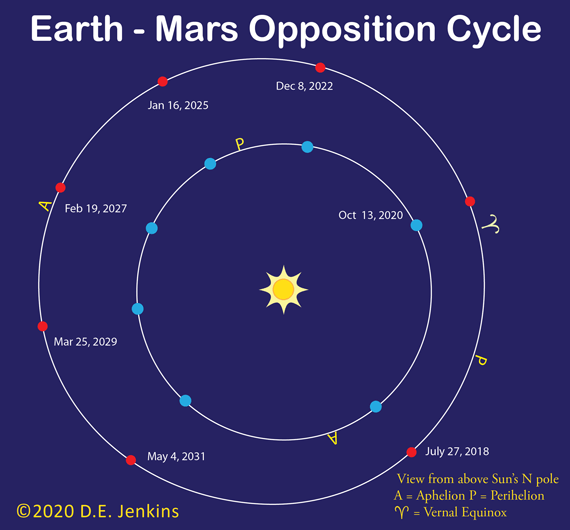
The Earth/Mars opposition cycle can be seen in the diagram. The first opposition in the cycle is the 2018 opposition that is shown at the lower right. The image shows the solar system as though we are looking down on the sun's north pole. Although the orbits are shown here with some accuracy, the images of the Sun, Earth, and Mars are not drawn to scale. The planets are represented in the diagram by blue (Earth) and red (Mars) dots. The orbits are both marked with apsides. Apsides are positions of an orbiting body. In this diagram, "A" means "aphelion" or farthest from the sun and "P" means "perihelion" or closest to sun. The astronomical symbol "♈" means the first point of Aries. This marks the 0-degree point for RA in Earth coordinates and therefore helps to orient the orbit. This is the exact orbital location of spring equinox for Earth. To the Earth-based observer, it seems as if the Sun is located in the constellation of Pisces.
The cycle normally contains 3 perihelic oppositions and 4 aphelic oppositions. Mars' orbital motion near perihelion is faster than at aphelion so there is a greater distance between perihelic oppositions as compared to aphelic.
Perihelic Opposition
The best oppositions of Mars take place when Mars is close to perihelion in its orbit, and are called "perihelic" oppositions. The cycle in the opposition diagram begins at the 2018 opposition of Mars that was a perihelic opposition. Perihelic oppositions are the best because Mars is near the closest point in its orbit around the Sun. When Mars is closer to the Sun, Mars is also closer to us. In addition, perihelic oppositions normally occur in August or September when Earth is farther from the Sun and therefore closer to the red planet. The most favorable perihelic opposition occurred in 2003 when Mars and Earth were separated by a mere 55.72 million km (34.62 million miles.
During the 2018 apparition (lower right), Mars was still approaching its perihelion on July 27, so it was closest to the Earth on July 31, a little more than 4 days later. After that, the Earth sped away from the red planet, only to meet up again in 2020. When perihelic oppositions occur, they all have similar characteristics. Because Mars is located on the southern side of the ecliptic, perihelic opposition will always be more favorable to earth-based observers in the southern hemisphere. During a perihelic opposition, Mars will appear in Earth's sky near to the winter solstice position of the Sun. In 2018, Mars was at -25 degrees in Earth's sky and appeared very low to those north of the equator. Mars is also inclined to its orbit, its axial tilt is 25.2 degrees and the southern hemisphere is pointed toward the Sun during perihelic oppositions. Mars' orbit and axial tilt means that southern summers are shorter and hotter than southern winters. The seasons are not equal: summer in the north lasts 182 days, while southern summers are 160 days. Because the south pole is easier to see at perihelic passes, it was better mapped and known before the space age. The seasonal differences mean that Mars north polar cap (1100 km) is larger than the southern cap (400 km) that may disappear completely during the summer months. The seasonal differences on Earth are balanced by the large oceans and in any case are not as great since its orbit is more circular.
Aphelic Opposition
The least favorable oppositions of Mars take place when Mars is close to aphelion (farthest from the Sun) in its orbit and are called "aphelic" oppositions. The Earth/Mars opposition cycle diagram shows that the next aphelic extreme opposition is the February 19, 2027 opposition is shown at the upper left in represented by the disks of Earth(blue) and Mars(red).
Mars approaches aphelion on February 19, so it is farthest from the Sun on March 2, and the Earth reaches its own perihelion January 3 more than a month earlier. This means the two planets are about as far away from each other as they can be during that opposition. At that time the magnitude of Mars will be -1.2 far dimmer than its best perihelic opposition at magnitude -2.8. After that, the Earth speeds away from the red planet, only to meet up again for the 2028-2029 aphelic apparition.
When aphelic oppositions occur, they all have similar characteristics. Because Mars is located on the northern side of the ecliptic, aphelic opposition will always be more favorable to earth-based observers in the northern hemisphere. In 2027, Mars will be at 25 degrees in Earth's sky and appear low to those south of the equator. Mars is also inclined to its orbit, its axial tilt is 25.2 degrees and it will be pointing its northern hemisphere toward the Sun during aphelic oppositions. Mars' orbital motion near aphelion is slower than at perihelion so there is a less distance between aphelic oppositions as compared to perihelic. Mars' orbit and axial tilt means that in the northern hemisphere has longer winters and spring is longer than summer and autumn.
Mars Special Tricks around Opposition
Mars takes an interesting path through the sky while the planets move toward opposition. The distant planets stood out from the background stars for the early human observers who were dazzled by their brilliance and puzzled by the fact that they did not travel in the same direction as the stars. Planets take a different path, because they are orbiting the Sun in a counterclockwise motion. Unlike stars, planets could change in magnitude, especially Mars because its distance varies so much between conjunction and opposition.
As the planets go about their orbits, Mars appears to move through the constellations on the ecliptic in a regular pattern from West to East as viewed from Earth. This is contrary to the motion of the stars that move from East to West as the Earth rotates. So during the months preceding opposition, Mars becomes bright, calling attention to itself for astronomers or anyone looking up who can see that bright red warrior. By the time it reaches western quadrature it has reached first magnitude or better. Soon the red planet will rise around midnight. At first Mars seems to behave as usual, but then it does a little dance, and starts to move in the opposite direction or retrograde motion.
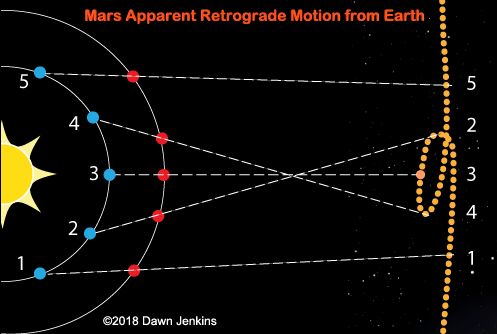
Before retrograde motion begins, Mars seems to stand still. This can be thought of as Earth, coming around the curve of its orbit so that Mars appears to quit moving. This is merely our line-of-sight. It's like being on a train when it is being passed by a faster train. If you are looking out the train window, suddenly you feel like you are moving backwards. Earth and Mars are doing something like this, the blue planet is lapping the red planet on their orbital tracks. About a month before opposition, Mars hit its first stationary point. After that it travels in a backward direction (East to West) until after opposition when it hits another stationary point. After that it resumes its normal course, although it really did nothing but continue to maintain its usual orbit. It is only our line-of-sight that makes Mars and other outer planets seem to move in a loop or sometimes an ess-curve against the background stars.
The diagram shows how this works. Earth position is marked in blue and the Mars position is marked in red. An observer on the Earth looks at Mars when they are located at the 1 position. The Earthling sees Mars against the star background moving in its usual prograde motion from west to east. A short while later both Earth and Mars arrive at the second position, Mars appears to stand still and retrace its steps. At position 3, the observer is treated to the happy circumstance of Mars at opposition. The Sun is behind the Earth, the disk of Mars is 100% illuminated. Mars spent all night in the sky on July 27, 2018 and the disk was 24.3" in diameter. At position 4, the Earth observer sees that Mars is stopping and returning to its normal contrary motion moving from west to east against the background field of stars. At position 5, Mars has been left behind and both planets orbit the Sun until their mutual speeds and positions reunite them for the next opposition. The disk shrinks and will continue to do so until Mars disappears behind the Sun in September 2019.
Mars path through Capricornus 2018
The best perihelic opposition shown in the above Mars opposition cycle diagram was in 2018, when Mars moved through the constellation of Capricornus. This chart demonstrates the retrograde loop in the apparent path of Mars as seen from Earth. As Mars moved through Capricornus the planet appeared to move backward, that is from East to West. For about 2 months, equally spaced around opposition, the planet Mars was in retrograde motion.
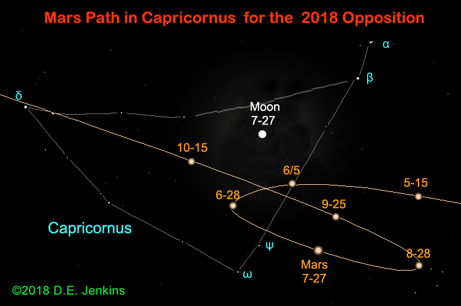
Mars Disk Comparison
The first disk of Mars on the chart below represents the size and magnitude of the disk of Mars when it is not heading for an opposition. This tiny disk may represent the view of Mars when it is far from Earth. When far out there the planet Mars presents a small disk, not quite 4 arc-secs in diameter. It will shine at 1.6 magnitude or somewhat less. This is equivalent to the appearance of Alioth, the first star in the handle of the Big Dipper, close to the bowl. As you can see a star as faint as this could really get lost in a bright star field or close to the horizon before sunrise or after sunset. This is when I really see the planet displaying a deep red color.

How dramatic the difference is shows emphatically when placed next to the apparent disk of Mars at the 2018 opposition when the planet is at closest approach. For the next 15 years, the disk of Mars will never grow to such impressive size or magnitude. When observing solar system planets, make no mistake, bigger really is better. Resolution is improved when the planet is closer to Earth, rather than far away. The larger the aperture of the telescope the better Mars can be seen and for orbiting instruments placed high above the Earth's atmosphere, so much the better to view that far away red dot. And how far away Mars can really get! When Mars is far away it can be up to 401 Mkm distant. Compare that number to the 2003 Opposition close approach at 55,758,006 km and realize that Earth pulls away from Mars after every opposition.
Communications that take 3 minutes to travel to Earth when Mars is close compared to 22 minutes it takes to get to Earth when Mars is far away. Waiting for a return message is equally time consuming. There is just no shortcut because communications are limited to the speed of light. In addition, if Mars is hidden by the Sun, there will be no communications until the planets once again have a line-of-sight.
Some helpful links
Find out which side of Mars is visible while you are out viewing the red planet through a telescope. Sky & Telescope magazine features an interactive application, Mars profiler. Use this tool to find out what side of the martian surface is currently in your viewfinder or check up on the time of your observation.
Mars Apparition 2020 - 2021 - Damien Peach excellent images of the Mars 20-21 opposition
Don't miss out on other pages at this excellent site for astronomical images at Views of the Solar System - at DamienPeach.com
Oppositions of Mars - Nakedeyeplanets.com - by Martin J. Powell
Naked Eye planets is a excellent resource for anyone interested in observing Mars or other planets in the solar system. A very detailed description of the path that Mars takes during an opposition is available at the site.
A.L.P.O. MARS Section - American League of Planetary Observers
B.A.A. Mars Section - British Astronomical Association
Hubble Space Telescope Images of Mars at Opposition
Mars in opposition in 2018 (annotated) - Labels features visible shortly before opposition through dust storm
New Hubble Portrait of Mars- HST is a fantastic instrument for exploration of the red planet. During the 2016 opposition, this feature article shows how Hubble can view Mars at an opposition and detect features as small as 20 miles across.
Mars 2016/2018 side-by-side - Show how different Mars looked in 2016 from 2018 due to dust storm and Mars-Earth circumstances
Animation of difference in Mars orientation, 2016 and 2018 - This shows how different seasons on Mars change the planet's appearance for Earth observers. Because the south pole is pointing toward the Sun, Hellas Basin can be seen more clearly during perihelion apparitions.
One last image that I really love because Saturn was at opposition a month earlier than Mars in 2018 when 3 oppositions in quick succession including Jupiter at opposition. In 2020, Saturn and Jupiter are at opposition in July. This image shows that Hubble Space Telescope is a planetary instrument as well as a deep sky marvel:
For more observation tips go here to this month's What's up article/observing Mars.
For drawing help go here to this month's What's up article/drawing Mars.
To find out about Earth's missions to Mars, go to Astra's Mars Exploration page.
If you love the red planet as much as Astra does, check out Astra's Star Gate's 3 Faces of Mars page!
